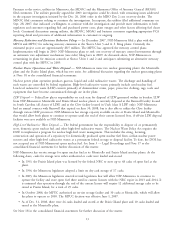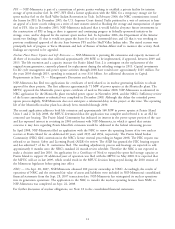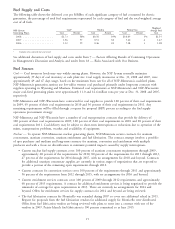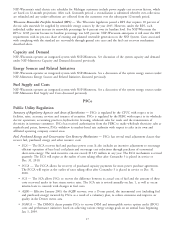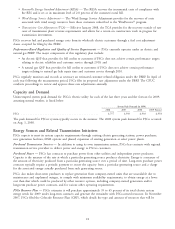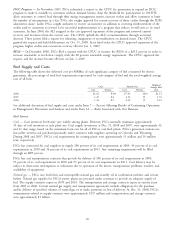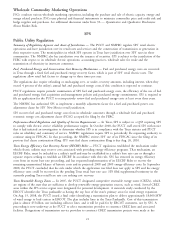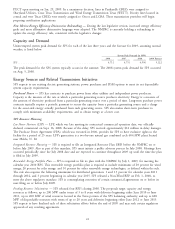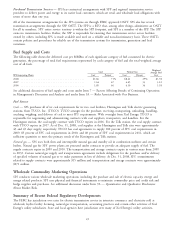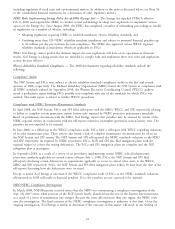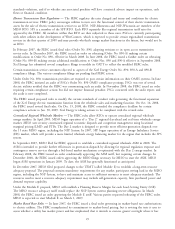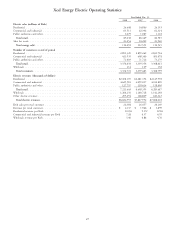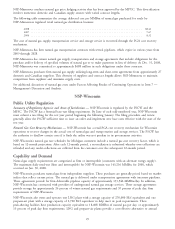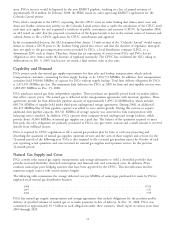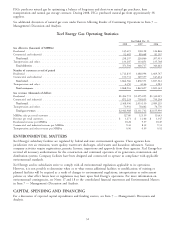Xcel Energy 2008 Annual Report Download - page 32
Download and view the complete annual report
Please find page 32 of the 2008 Xcel Energy annual report below. You can navigate through the pages in the report by either clicking on the pages listed below, or by using the keyword search tool below to find specific information within the annual report.
PUCT open meeting on Jan. 29, 2009. In a unanimous decision, lines in Panhandle CREZs were assigned to
Sharyland Utilities, Cross Texas Transmission and Wind Energy Transmission Texas (WETT). Priority lines located in
central and west Texas CREZs were mostly assigned to Oncor and LCRA. These transmission providers will begin
preparing certification applications.
New Mexico Energy Efficiency Disincentive Rulemaking — During the last legislative session, increased energy efficiency
goals and more affirmative disincentive language were adopted. The NMPRC is currently holding a rulemaking to
update the energy efficiency rule, consistent with the legislative changes.
Capacity and Demand
Uninterrupted system peak demand for SPS for each of the last three years and the forecast for 2009, assuming normal
weather, is listed below.
System Peak Demand (in MW)
2006 2007 2008 2009 Forecast
SPS................................................ 4,711 4,731 4,996 5,122
The peak demand for the SPS system typically occurs in the summer. The 2008 system peak demand for SPS occurred
on Aug. 5, 2008.
Energy Sources and Related Transmission Initiatives
SPS expects to use existing electric generating stations, power purchases and DSM options to meet its net dependable
system capacity requirements.
Purchased Power — SPS has contracts to purchase power from other utilities and independent power producers.
Capacity is the measure of the rate at which a particular generating source produces electricity. Energy is a measure of
the amount of electricity produced from a particular generating source over a period of time. Long-term purchase power
contracts typically require a periodic payment to secure the capacity from a particular generating source and a charge
for the associated energy actually purchased from such generating source. SPS also makes short-term purchases to
comply with minimum availability requirements, and to obtain energy at a lower cost.
SPS Resource Planning
Lea Power Partners (LPP) — LPP, which was late meeting its contractual commercial operation date, was officially
declared commercial on Sept. 16, 2008. Because of the delay, SPS received approximately $12 million in delay damages.
The Purchase Power Agreement (PPA), which was executed in 2006, provides for SPS to have exclusive rights to the
facility for a period of 25 years. LPP’s generation is a two-by-one natural gas combined cycle 604 MW plant located
near Hobbs, N. M.
Integrated Resource Planning — SPS is required to file an Integrated Resource Plan (IRP) before the NMPRC on or
before July 2009. Also as part of this mandate, SPS must initiate a public advisory process by July 2008. Meetings have
occurred periodically since the July 2008 date and are expected to continue throughout 2009 up until the time the plan
is filed in July 2009.
Renewable Energy Portfolio Plan — SPS is required to file its plan with the NMPRC by July 1, 2009, for meeting the
calendar year 2010 RPS. This renewable energy portfolio plan is required to include minimums of 20 percent for wind
energy, 20 percent for solar energy, and 10 percent for other renewable energy technologies, as defined within the rule.
The rule also requires the following minimums for distributed generation: 1 and 1.5 percent for calendar years 2011
through 2014, and 3 percent beginning in calendar year 2015. SPS released a Non-Wind RFP on Feb. 1, 2008, to
meet the above regulatory mandate. SPS is contemplating execution of certain commercial agreements on or before its
next filing on or before July 2009.
Pending Resource Solicitations — SPS released four RFP’s during 2008. The proposals target capacity and energy
resources as follows; up to 200 MW under terms of 3 to 8 years with deliveries beginning either June 2010 or June
2011, up to 200 MW of wind resources located in the Texas portion of the SPS balancing authority, and up to 600
MW of dispatchable resources with terms of up to 20 years and deliveries beginning either June 2012 or June 2013.
SPS expects to have finalized each of these solicitation efforts before the end of 2009 and may seek certain regulatory
approvals of any resulting agreements.
22



